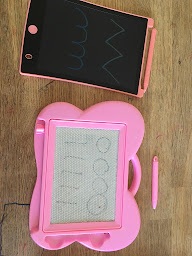They need to develop whole body muscles (gross motor), to control their upper body and shoulders as well as develop the desire to sit still and concentrate.
Many of these initial skills can be supported by play through being active and being outside. Hand-eye coordination is also key for writing as is the need for children to build up the control in their hands and fingers (fine motor skills).
The marks children begin to make slowly start to have more meaning for them and at first may seem like random swirls but soon you may see the emergence of circles, lines and dots. They will then start to bring this into their role play in copying marks they see and create their own 'pretend' writing.
Once children begin school, we will start to teach them how to form their letters and we will give you guidance on how they form the cursive letters. In the meantime, we need to encourage them to play at writing. We find that children who are corrected too often, or asked to write things out ‘properly’ may lose interest. On the other hand, children who enjoy the process of mark making and ‘writing’ notes that are praised and valued will naturally want to do it more often, and so get better at it.
Ideas to encourage mark making
Some children love to use pens, crayons, pencils or even felt-tipped pens to colour and draw. Not every child is so keen on activities like this so you may have to be inventive. You can use a range of different materials around the house such as:
- Foil, cling film, greaseproof paper
- Feathers, leaves, sticks - anything from outside!
- Felt
- Pipe cleaners
- Cotton Wool
- String
- Pens, Pencils, Crayons
- Spatulas, Spoons, Forks, Whisks
- Carrots, cucumber, potatoes
You can dip these in paints, cornflour and water, sand, flour, or even shaving foam.
Here are a few ideas that we have used in our homes and school...
 |
| Draw patterns for them to copy |
 |
| Use chalks to write names or make patterns |
 |
| These are chalk pens that can write on glass |
 |
| Nail varnish can be quite toxic but paints do the job just as well |
  |
You can freeze poster paints and use your hands to melt them. It can get messy!  Drive cars through paint |














